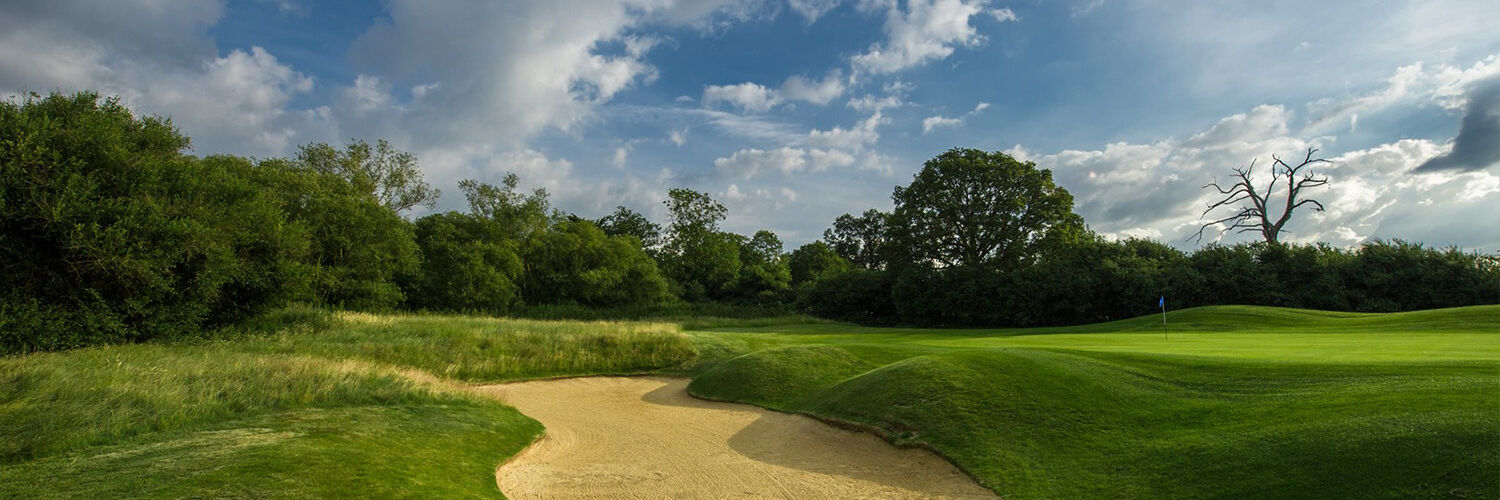Contact for all enquiries on Course Rating: course.rating@hertfordshiregolf.org or club.services@hertfordshiregolf.org
The USGA Course Rating System is the standard upon which handicaps are built. It drives the calculation of a Handicap for all golfers and is a central feature of the new World Handicap System that is being introduced throughout 2020.
The USGA Course Rating System takes into account the factors that affect the playing difficulty of a golf course.
Course rating teams from Hertfordshire Golf carry out the on-course portion of the rating process across the county. England Golf reviews the work of the teams and then issues the ratings.
Accuracy and consistency are the keys to effective course rating. A course must first be accurately measured. The measured yardage must then be corrected for the effective playing length. These effective playing length corrections are roll, elevation, dogleg/forced lay-up, prevailing wind, and altitude. Obstacles that affect playing difficulty must then be evaluated in accordance with established standards. These standards increase objectivity in course rating.
Important Definitions
The following are terms essential to the USGA Course Rating System:
Scratch Golfer: A male scratch golfer is a player who can play to a Course Handicap of zero on any and all rated golf courses. A male scratch golfer, for rating purposes, can hit tee shots an average of 250 yards and can reach a 470-yard hole in two shots.
A female scratch golfer is a player who can play to a Course Handicap of zero on any and all rated golf courses. A female scratch golfer, for rating purposes, can hit tee shots an average of 210 yards and can reach a 400-yard hole in two shots at sea level.
USGA Course Rating: A USGA Course Rating is the evaluation of the playing difficulty of a course for scratch golfers under normal course and weather conditions. It is expressed as the number of strokes taken to one decimal place (72.5), and is based on yardage and other obstacles to the extent that they affect the scoring difficulty of the scratch golfer.
Bogey Golfer: A male bogey golfer is a player who has a Course Handicap of approximately 20 on a course of standard difficulty. He can hit tee shots an average of 200 yards and can reach a 370-yard hole in two shots at sea level.
A female bogey golfer is a player who has a Course Handicap of approximately 24 on a course of standard difficulty. She can hit tee shots an average of 150 yards and can reach a 280-yard hole in two shots.
Bogey Rating: A Bogey Rating is the evaluation of the playing difficulty of a course for bogey golfers under normal course and weather conditions. It is expressed as the number of strokes taken to one decimal place (92.1), and is based on yardage and other obstacles to the extent that they affect the scoring difficulty of the bogey golfer.
Slope Rating: A Slope Rating is the USGA mark that indicates the measurement of the relative playing difficulty of a course for players who are not scratch golfers, compared to scratch golfers. It is computed from the difference between the Bogey Rating and the USGA Course Rating times a constant factor and is expressed as a whole number from 55 to 155.
The Rating Process
The rating process requires a study of each hole, including detailed data obtained at all landing zones for both the scratch and the bogey golfer. The rating teams use the average shot lengths for both scratch and bogey golfers to determine the landing zones. Length corrections and obstacle values are considered at each landing zone.
Effective Playing Length Factors
The following correction factors are evaluated to determine if the hole is effectively longer or shorter than the actual measured length:
Roll: Roll is an evaluation of how far full shots for scratch and bogey golfers roll, and the effect that has on the playing length of the course. For example, it considers whether a drive from the tee lands on a slope that is uphill or downhill.
Elevation: Elevation is a measure of how changes in elevation from tee to green affect the playing length of a hole.
Dogleg/forced lay up: Dogleg/forced lay-up is a measure of how much longer or shorter a hole is played because it has a bend (allowing players to cut the corner or forcing them to lay up), or because it has obstacles, such as water or deep bunkers, crossing the fairway in the players' landing zones (which force the scratch or bogey golfer to hit less than a full shot).
Prevailing Wind: Prevailing wind is a measure of the effect of constant wind on seaside courses, plains courses, or other courses unprotected from the wind.
Altitude: Altitude is an evaluation for courses at 2,000 feet or more altitude that will play shorter than their measured length because shots fly farther in the thin air.
Obstacle Factors
The following obstacle factors are determined for each landing zone for both the scratch and the bogey golfer:
Topography: is a factor if the stance or lie in the landing zone is affected by slopes or mounds, or the shot to the green is uphill or downhill, making club selection more difficult.
Fairway: is an evaluation of the difficulty of keeping the ball in play from tee to green. Fairway ratings are based on fairway width in all landing zones, hole length, and nearby trees, hazards, and punitive rough.
Green Target: is an evaluation of the difficulty of hitting the green with the approach shot. Primary considerations are green size, approach shot length, and green surface visibility, firmness, and contour.
Recoverability and Rough: is the evaluation of the probability of missing the tee shot landing zone and the green, and the difficulty of recovering if either, or both, is missed. The Green Target rating drives the Recoverability and Rough rating value.
Bunkers: is the evaluation of their proximity to target areas and the difficulty of recovery from them. The Green Target rating also drives the Bunkers rating value.
Crossing Obstacles: consist of penalty areas, extreme rough and out of bounds. Ratings are based on the shot length required to safely carry the crossing obstacle.
Lateral Obstacles: consist of penalty area, extreme rough and out of bounds. These are evaluated at each landing zone. The rating being based on shot length required to reach the landing zone and the distance of the lateral obstacle from the centre of the landing zone (fairway or green).
Trees: is the evaluation of the size and density of the trees, their distance from the centre of the landing zone or green, the length of the shot to that target, and the difficulty of recovery.
Green Surface: is the evaluation of a green's difficulty from a putting standpoint. Green speed and surface contouring are the main factors. The size of the green is considered irrelevant in evaluating putting difficulty. A Stimpmeter is utilized to measure the speed of the greens based on midseason conditions.
Psychological: is the evaluation of the cumulative effect of the other obstacles. The location of many punitive obstacles close to a target area creates uneasiness in the mind of the player and thus affects his or her score. This value is purely mathematical and is added after the on-course rating is complete.
Each obstacle is assigned a value of 0 to 10, depending on its relation to how a scratch or bogey golfer would play the hole. When the evaluation is complete, the numbers for each hole's obstacles are totalled and multiplied by a relative weighting factor. The weighted obstacle stroke values are applied to scratch and bogey formulas and then converted to strokes. Those strokes are added or subtracted from the Yardage Rating to produce a Bogey Rating and USGA Course Rating, and the difference between those two values multiplied by a constant factor is the Slope Rating.
Courses must be re-rated at least every 10 years, or if it is a new golf course, within 5 years. If significant changes have been made to the course it will need to be re-rated. The club should notify the Hertfordshire Course Rating Team by emailing the course.rating@hertfordshiregolf.org giving details of the changes.



